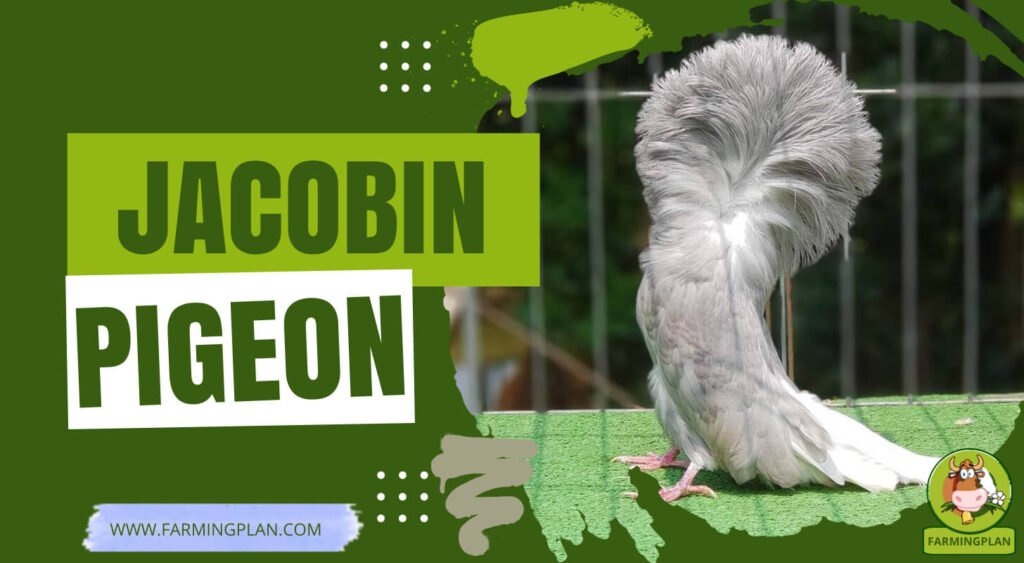If you’re a pigeon enthusiast like me, you’ve likely come across the stunning Jacobin Pigeon. When I first saw these beautiful birds, with their distinctive ruff and graceful demeanor, I knew I had to learn more. This Jacobin Pigeon has been one of the most rewarding experiences in my bird-keeping journey. Their vibrant personalities and unique characteristics make them a joy to care for. From their fascinating history to their unique diet and breeding tips, I’m excited to share all the details that make Jacobin Pigeon extraordinary.

Jacobin Pigeon Characteristics
Jacobin Pigeon are known for their unique and eye-catching features, making them a fascinating species to observe and care for.
Physical Features
These pigeons are easily recognized by their striking ruff, a feathered collar around their neck, which is more prominent in adults. They are medium-sized birds weighing between 250 and 350 grams, with a robust build and strong wings. Jacobin Pigeon come in various color variations, including white, black, brown, or a mix, adding to their charm.
Behavioral Traits
Jacobin Pigeons have a calm and friendly temperament, making them excellent companions. They are social and enjoy the company of other pigeons, communicating through soft cooing sounds. Known for their agility, they love to fly and are active, often performing acrobatic maneuvers. These pigeons form strong bonds with their owners and are not shy, usually seeking attention. While generally peaceful, they may become territorial when their space or resources are threatened. Proper care and a well-maintained environment help manage such behavior.
Read More: The Fantail Pigeon
History of the Jacobin Pigeon
The Jacobin Pigeon has a rich history that dates back centuries. This section will explore its origins, cultural significance, and how this fascinating bird has evolved over time.
Origins of the Jacobin Pigeon
The Jacobin Pigeon is believed to have originated in India. Early records suggest that traders brought these birds to Europe in the 16th century. They were initially bred for their unique appearance and flying abilities. The ruff around the neck, which is so distinctive today, likely became more pronounced through selective breeding. The Jacobin Pigeon became popular among bird enthusiasts due to its exotic look and graceful flight.
The Cultural Significance of These Pigeons Throughout History
Throughout history, Jacobin Pigeon have been admired for their beauty. They were often featured in art and literature, symbolizing grace and elegance. Pigeons, including the Jacobins, were seen as symbols of peace and love in many cultures. They were kept in royal aviaries and gardens and sometimes used in ceremonial events. Their rarity and beauty also made them a prized possession among bird fanciers.
How They Were Bred and Their Evolution Over Time
Selective breeding played a significant role in shaping the Jacobin Pigeon’ appearance. Over the years, breeders focused on enhancing the size and shape of the ruff and the birds’ color patterns, leading to the various color variations we see today. As a result, Jacobin Pigeon evolved into the distinct, graceful birds we recognize now, admired worldwide for their unique charm.
Read More: Baja Tumbler Pigeon
Jacobin Pigeon Care
Caring for This Pigeon requires a spacious, clean environment and a balanced diet to ensure their health and well-being. Regular social interaction, proper grooming, and attention to their living conditions are essential for a happy and healthy bird.
Housing Requirements
Jacobin Pigeons need a spacious, clean, and safe environment. They should have access to a large aviary or outdoor cage. The space should allow them to fly freely and exercise their wings. For breeding, it’s essential to include small, quiet nesting boxes where they can rest and lay eggs. As for temperature, these pigeons are adaptable but prefer moderate climates. Keeping them in areas that avoid extreme cold or heat is crucial for their well-being. Providing proper ventilation is also essential to keep the air fresh and dry.
Health Considerations
Jacobin Pigeon are generally healthy, but like all birds, they can suffer from common health issues. Respiratory infections, such as colds or flu, are common, especially in damp or poorly ventilated conditions. To prevent this, clean and dry their living space and provide fresh water regularly. Regularly checking their feathers and eyes for signs of infection can help catch problems early. Other health issues include parasites like mites or worms, so regular vet checkups are recommended.
Grooming
The ruff around the neck is one of the most critical features of the Jacobin Pigeon. Keeping this area clean and well-groomed is essential. Gently combing the ruff with a soft brush can prevent mats or tangles. Also, regular baths will help keep your pigeon’s feathers shiny and healthy. A shallow dish of clean water will encourage them to bathe. Keep their living space clean by removing droppings daily to avoid build-up, which can lead to health problems. Regular grooming helps your pigeon stay comfortable and look its best.
Read More: Armenian Tumbler Pigeon
Jacobin Pigeon Diet
A balanced diet is essential for the health of Jacobin Pigeon. Their diet should include a variety of seeds, grains, and supplements to meet their nutritional needs.
Key Elements of a Healthy Diet
Jacobin Pigeon require seeds like millet, sunflower, and safflower, as well as grains such as corn and wheat. These provide the energy they need to stay active. Additionally, they benefit from occasional supplements, like crushed oyster shells for calcium, to support healthy bones and eggs.
Feeding Frequency and Water Requirements
Feed them twice a day, providing fresh food each time. They should always have access to clean water. This helps keep them hydrated and supports digestion. Regularly changing their water is essential to prevent contamination.
Breeding Jacobin Pigeons
Breeding this Pigeon requires careful attention to create the conditions for their reproduction.
Ideal Conditions for Breeding
Jacobin Pigeon need a quiet, safe environment for breeding. Provide a clean, spacious nesting area with soft bedding like straw or hay.
Courtship and Mating Behaviors
During courtship, male pigeons perform a display by puffing up their ruff and cooing to attract a mate. Once mated, they form strong bonds.
Care for the Eggs and Young Pigeons
After the female lays eggs, both parents take turns incubating them. Once the chicks hatch, both parents feed them a special secretion called “pigeon milk.”
Tips for Breeding Success
Ensure a stress-free environment, proper diet, and clean living space to encourage successful breeding.
Jacobin Pigeon Training Tips
Training your Jacobin Pigeon can be a fun and rewarding experience. Here are some tips to help you get started.
Training for Flying or Tricks
Start by letting your pigeon get familiar with its environment. Gradually encourage it to fly short distances, offering treats as rewards. To train tricks, use positive reinforcement, rewarding with food when the bird performs the desired action.
Socialization Tips for Young Pigeons
Handle young pigeons gently and often to help them get used to human interaction. Socializing them early makes them more comfortable around people and other pigeons.
Creating a Bond with Your Jacobin Pigeon
Spend time with your pigeon daily, talking to it or feeding it by hand. Building trust will strengthen your bond.
Common Problems with Jacobin Pigeons
Like any pet, this pigeon may face health or behavioral issues. Being aware of these problems helps manage them early.
Health Problems
Common health problems include respiratory infections, which can cause coughing or wheezing. Feather loss might happen due to mites or poor diet. Keep the living area clean and monitor their health regularly.
Behavioral Issues
Some pigeons may display aggression or fear of humans, especially if they’re not socialized early. To manage this, handle your pigeon gently and frequently, giving it time to trust you.
Identifying and Managing Issues
Look for signs of illness, such as changes in behavior, appetite, or appearance. Consult a vet early if needed. Regular care and attention can prevent most problems.
Additional Ideas for Jacobin Pigeon Enthusiasts
For this Pigeon enthusiasts, there are many ways to enrich their experience beyond basic care. These additional ideas will help them take their passion to the next level.
Building a Breeding Loft or Aviary
A proper breeding loft or aviary is essential for raising healthy Jacobin Pigeon. Ensure the space is spacious, clean, and secure. Include perches, nesting boxes, and plenty of ventilation to keep your pigeons comfortable. A large aviary allows the pigeons to fly freely, vital for their well-being.
Participating in Pigeon Shows or Competitions
If you’re proud of your Jacobin Pigeon, consider entering them in pigeon shows or competitions. These events are a great way to showcase your birds and connect with other pigeon enthusiasts. It’s also a fun way to learn more about breeding standards and how to improve your pigeons’ appearance and health.
Joining Pigeon Enthusiast Communities for Tips and Support
Joining online or local pigeon enthusiast communities can provide valuable tips and support. You’ll meet other pigeon lovers who share their experiences and insights. These communities can also help troubleshoot issues you may face and offer encouragement in your bird-keeping journey.
FAQ
What is the Jacobin Pigeon known for?
The Jacobin Pigeon is known for its unique ruff around the neck and graceful flight.
What is the ideal diet for a Jacobin Pigeon?
Jacobin Pigeon need a balanced diet of seeds, grains, and occasional supplements for calcium.
How do I train my Jacobin Pigeon?
Train your Jacobin Pigeon using positive reinforcement, rewarding it with treats when it performs desired actions.
What are common health issues for Jacobin Pigeon?
This Pigeon can face respiratory infections and feather loss, often due to poor living conditions.
How do I build a good aviary for my Jacobin Pigeon?
A good aviary should be spacious, clean, secure, and well-ventilated, with perches and nesting boxes.
Conclusion
Caring for Jacobin Pigeons involves providing a balanced diet, a clean and spacious environment, and proper socialization. These pigeons are unique due to their distinct ruff and thrive in environments that allow them to fly and interact. Regular health checks, training, and strong bonds with your bird are key to their well-being. Engaging in breeding, joining pigeon communities, or participating in shows can further enhance your experience as a Jacobin Pigeon enthusiast. By following these guidelines, you can ensure your pigeons remain healthy, happy, and well-cared for.


